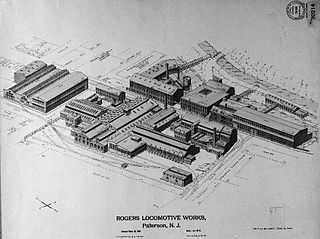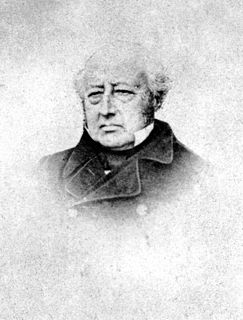
The Baldwin Locomotive Works (BLW) was an American manufacturer of railroad locomotives from 1825 to 1951. Originally located in Philadelphia, it moved to nearby Eddystone, Pennsylvania, in the early 20th century. The company was for decades the world's largest producer of steam locomotives, but struggled to compete as demand switched to diesel locomotives. Baldwin produced the last of its 70,000-plus locomotives in 1951, before merging with the Lima-Hamilton Corporation on September 11, 1951, to form the Baldwin-Lima-Hamilton Corporation.

Orenstein & Koppel was a major German engineering company specialising in railway vehicles, escalators, and heavy equipment. It was founded on April 1, 1876 in Berlin by Benno Orenstein and Arthur Koppel.

George Washington Whistler was a prominent American civil engineer best known for building steam locomotives and railroads. He is credited with introducing the steam whistle to American locomotives.

Under the Whyte notation for the classification of steam locomotives, 4-2-0 represents the wheel arrangement of four leading wheels on two axles, two powered driving wheels on one axle and no trailing wheels. This type of locomotive is often called a Jervis type, the name of the original designer.

Rogers Locomotive and Machine Works was a 19th-century manufacturer of railroad steam locomotives based in Paterson, in Passaic County, New Jersey, in the United States. It built more than six thousand steam locomotives for railroads around the world. Most 19th-century U.S. railroads owned at least one Rogers-built locomotive. The company's most famous product was a locomotive named The General, built in December 1855, which was one of the principals of the Great Locomotive Chase of the American Civil War.

Moncure Robinson was an American civil engineer, railroad planner and builder and a railroad and steamboat owner, who is considered one of America's leading Antebellum period civil engineers. He was educated at the College of William and Mary and at the Sorbonne; his most noted project was the Philadelphia & Reading Railroad.

Foster, Rastrick and Company was one of the pioneering steam locomotive manufacturing companies of England. It was based in Stourbridge, Worcestershire, now West Midlands. James Foster, an ironmaster, and John Urpeth Rastrick, an engineer, became partners in 1816, forming the company in 1819. Rastrick was one of the judges at the Rainhill Trials in 1829. The company was dissolved on 20 June 1831.
Bromsgrove railway works was established in 1841 at Aston Fields, near Bromsgrove, Worcestershire, England as a maintenance facility for the Birmingham and Gloucester Railway. However, as well as maintaining those provided by other manufacturers, it built one locomotive.
Septimus Norris was an American mechanical engineer and steam locomotive designer. He was the youngest of three brothers all active in the field — his eldest brother William Norris founded the Norris Locomotive Works of Philadelphia, Pennsylvania, and Richard Norris took over the firm in about 1841. The other two brothers were primarily businessmen, while Septimus was an engineer. He worked for the Norris firm under William's management, but did not continue under Richard's; railway historian John H. White, Jr. believes animosity existed between Septimus and Richard. Septimus later worked for the Portland Company and the Schenectady Locomotive Works.

Jones, Turner and Evans was a locomotive manufacturer in Newton-le-Willows, England from 1837, known as Jones and Potts between 1844 and 1852.
William Fairbairn and Sons, was an engineering works in Manchester, England.
B. Hick and Sons, subsequently Hick, Hargreaves & Co, was a British engineering company based at the Soho Ironworks in Bolton, England. Benjamin Hick, a partner in Rothwell, Hick and Rothwell, later Rothwell, Hick & Co., set up the company in partnership with two of his sons, John (1815–1894) and Benjamin (1818–1845) in 1833.

Rothwell, Hick and Rothwell was an engineering company in Bolton, England. Set up in 1822, the partners became interested in the production of steam locomotives after the Rainhill Trials. The company's first engine was Union, a vertical boiler, 2-2-0 with horizontal cylinders for the Bolton and Leigh Railway of which Hick and Rothwell were promoters and original shareholders, followed by three more locomotives the following year for American railways.

Neilson and Company was a locomotive manufacturer in Glasgow, Scotland.
George Forrester and Company was a British marine engine and locomotive manufacturer at Vauxhall Foundry in Liverpool, established by Scottish engineer George Forrester. The company opened in 1827 as iron founders and commenced building steam locomotives in 1834.

Edward Bury was an English locomotive manufacturer. Born in Salford, Lancashire, he was the son of a timber merchant and was educated at Chester.

William Mason is a 4-4-0 steam locomotive currently on display at the Baltimore and Ohio Railroad Museum in Baltimore, Maryland, United States. It was built for the Baltimore and Ohio Railroad, carrying that railroad's number 25. The locomotive is named in honor of its builder, William Mason, who built around 754 steam locomotives at his Mason Machine Works firm in Taunton, Massachusetts, from 1853 until his death in 1883. The engine had been one of the oldest operable examples of the American Standard design, and is the fourth oldest Baltimore and Ohio locomotive in existence, the oldest being the 0-4-0 no. 2, the Andrew Jackson from 1836, second oldest is the no. 8 0-4-0, John Hancock built later that same year, and the third being the 0-8-0 no. 57, Memnon of 1848. While operable, William Mason had been one of the oldest operational locomotive in the world, and the second oldest in the western hemisphere, after Robert Stephenson's 1831 John Bull built in 1831 for the Camden and Amboy Railroad, which is the world's oldest surviving operable steam locomotive.
New York Locomotive Works. Breese Kneeland and Company was a nineteenth century builder of steam locomotive engines located at Jersey City, New Jersey. Initially styled the New York Locomotive Works, the company was active under various ownerships in building steam locomotives from 1853 until 1873. The original proprietors were Charles Kneeland, William Hamilton and S. Breese. Encrease Personette Gould (1822-1876), usually known as E. P. Gould, a well known mechanic and formerly the mechanical superintendent of the Hudson River Railroad was the first shop foreman and designer.
Henry Roe Campbell was an American surveyor and civil engineer. Campbell contributed to American railroading and bridge-building in the first half of the 19th century. Campbell patented his 4-4-0 design in February 1836, just a few months before the patent law was changed to require that claims include proof of originality or novelty.

















